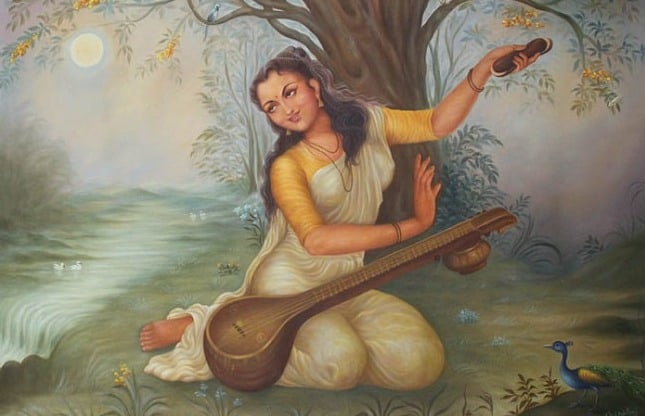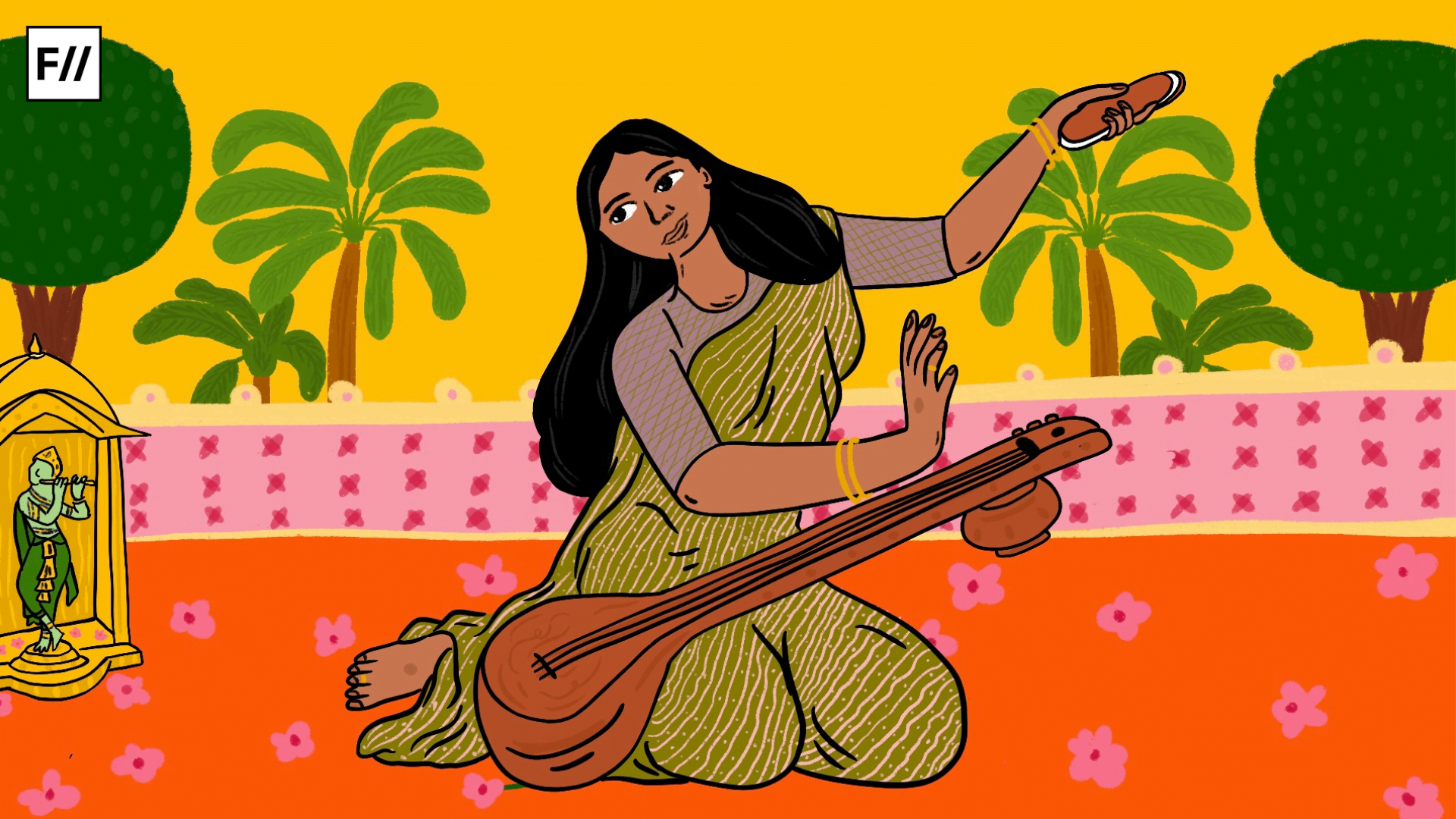Women’s history in the subcontinent owes a lot to the oral tradition and its absence would mean the obliteration of a huge chunk of it. We are also aware of the limitations of oral traditions; considering how, even in the case of Mira Bai, James Tod’s retelling of the history of Rajasthan has become the standard version preserved in popular memory. The faults in oral storytelling is highlighted in the distorted version of Rani Padmini’s legend as well, for which too James Tod is responsible.
James Tod was the political agent of the state of Mewar and during this time, he wrote his account ‘Annals and Antiquities of Rajasthan’. This was when the literary movement of Romanticism was finding expression in Europe, which led him to valorise the history of Rajasthan. At least in the case of Mira Bai, the animosity between her and the clan she was married into, was preserved during the period Tod is writing his account. Yet, he chose to gloss over the tension immersed in Mira’s tale, projecting her only as a female devotee lost in Krishna consciousness.
In the case of Mira Bai, the animosity between her and the clan she was married into, was preserved during the period James Tod is writing his account. However, he chose to gloss over the tension immersed in Mira’s tale, projecting her only as a female devotee lost in Krishna consciousness.
In northern India at least, there is probably no female bhakti poet whose bhajans are as easily recognisable as Mira’s and even though Mira’s tale has been reconciled with the mainstream, the animosity surrounding Mira’s tale was well-preserved until recent times. Her poetry isn’t just a reflection of her spiritual journey but is also an articulation of how Mira’s in-laws tried to restrain her freedom of expression. Parita Mukta is of the opinion that because Mira belonged to the Rajput aristocracy who controlled the chastity of their women strongly, Mira had to face excessive trials and tribulations.
Also read: Mirabai: A Tale Of Simultaneous Devotion And Subversion | #IndianWomenInHistory
According to Norman P. Ziegler who studied the Rajput clans in medieval India, there were two primary units of reference and identification for a Rajput. These were his brotherhood (bhaibandh) and his relations by marriage (saga). At the same time, the act of marriage was seen to unite a woman with her husband’s brotherhood. After marriage, the husband’s father usually gave his son’s wife a new name, which symbolised her ‘birth’ into the brotherhood.
The clan Mira belonged to also claimed descent from a single ancestor and Mira, through her actions of rejecting her marriage and moving into her natal home, seems to have violated the modesty of her brotherhood by violating ‘’kul maryada’’.

In the case of Mira, she did not just practise her devotion for Krishna within closed quarters but was also associated with a mandali of bhakts at a time, when women of the aristocracy irrespective of religion, observed purdah and women from respectable households did not engage in the performing arts.
Mira’s association with the mandali meant that as a married woman belonging to the aristocracy, she wasn’t just interacting with men outside her kin group but also with men from lower castes, which becomes an act of subverting the established social order, and poses a challenge to caste-based hierarchies. Mira’s rejection of her marriage into the aristocracy as well as her acceptance of Ravidas, an ‘untouchable’ as her Guru, becomes equivalent to flouting authority.
Through her act of defiance, Mira becomes a symbol of resistance towards authority and a performance of her bhajans by peasants and artisans is seen as an attempt of subverting caste-based hierarchies. Within Mewar, the very act of singing Mira becomes a political act, as her bhajans are a constant reminder of her rejection of authority and the bhajniks— who continue to sing Mira and often belong to so-called subordinate castes, are very well aware of that fact.
Bhakti poetry for the longest time has acted as the voice of the subaltern. It has been an instrument that forces at the peripheries have used to express their discontentment— the lingayats, the dadupanthis, the kabir panthis who broke away from the social order and became aberrations express their plight through these poems and these poems are an indispensable source to reconstruct the history of emotions.
The very act of singing Bhakti poetry becomes an act of defiance when we realise that many of these bhakti movements began as a challenge to the established order and hence, were egalitarian in their make up. For e.g. Virashaivism, the movement Akka Mahadevi was associated with, did not care for the barriers of caste, and encouraged women to participate in the movement. Similarly, Lal Ded’s vakhs in Kashmir, continuously question Brahmanical orthodoxy.
Even so, in order to reconcile Mira with the mainstream, there has been a glossing over of the uncomfortable aspects of Mira’s life. There has been a dissolution of the tension immersed in her tale and an erasure of the ‘caste’ from Mira’s history and poetry. Mira’s poetry which was once used to pose a challenge to caste-based hierarchy has now been accommodated into the social order. Mira’s history has been ‘disarmed’ in a way, so as to no more pose a threat to the existing social order; in the very same way that Islam has been conveniently erased from the anglicised translations of Rumi’s poetry.
It is crucial we realise that the likes of Mira, Rumi and other literary figures like Faiz Ahmad Faiz, Jaun Elia has been appropriated in a way to be marketed as cultural icons to a people, by the very same people who cannot seem to stand their histories.
It is crucial we realise that the likes of Mira, Rumi and other literary figures like Faiz Ahmad Faiz, Jaun Elia has been appropriated in the same way, which allows these figures to be marketed as cultural icons to a people, by the very same people who cannot seem to stand their histories. This appropriation of literary figures, has allowed a Rumi or a Mira to be conveniently placed beside a Frida Kahlo & a Virginia Woolf in order to not appear threatening, obscuring the real purpose of their literature and in the process, only serving the bourgeoisie.
Also read: The Bhakti Movement and Roots of Indian Feminism
Dissent is often hidden in poetry and it is crucial that we not let anyone erase this history of anger, as history among other things, must also remain an account of anger and an archive of emotions.
References
- Kothari, D. (n.d.) ‘Travelling Bards of India’, Facts and Fiction. Retrieved from: https://www.academia.edu/4177758/Traveling_Bards_of_India
- Chandra, B. (2009). History of modern India. New Delhi: Orient BlackSwan.
- Alam, M. (2015). The Mughal State, 1526-1750. New Delhi: Oxford University Press.
- Manushi: Women Bhakta poets. (1989). New Delhi: Manushi Trust.
- Bhartr̥hari, & Haksar, A. N. D. (2017). Introduction. Three hundred verses: Musings on life, love and renunciation. Gurgaon, Haryana, India: Penguin Books, an imprint of Penguin Random House.
- Chandra, S. (2012). State, society, and culture in Indian history. New Delhi: Oxford University Press. See Ch.3
- Bahuguna, R.P. (n.d.) Conflict and Assimilation in Medieval North Indian Bhakti: An Alternative Approach, SAP Programme, History Monograph-6
- Gandhi, N. M. (2013). ‘Rakhi Sawant of Sindh’ Alternative realities: love in the lives of Muslim women. New Delhi: Tranquebar.
- Sanni, A. ‘Perspectives in a Religious System: The Role and Status of Poetry in Islam’ Islamic Studies, vol. 29, no. 4, 1990, pp. 339–352. JSTOR, www.jstor.org/stable/20840010.
- From plassey to partition: A history of modern India. (2014). New Delhi: Orient Blackswan Private Limited.
Maria Uzma Ansari is an atheist and a feminist. She runs her own blog. She can be found on Instagram.





There are millions of articles written on the internet, but this really helped me, thank you for writing this.